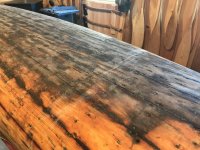Wood/canvas canoes can gain substantial weight on a trip because of waterlogging. Assuming no leaks, can the water penetrate from the outside through the paint and filler to get into the canvas and wood, or does the waterlogging happen only because of water (waves, slop, rain) getting inside the canoe?
-
Happy Disobedience Day! 🙈👎🏼🙅🏼♀️🚫🪧
How Do Wood/Canvas Canoes Get Waterlogged?
- Thread starter Glenn MacGrady
- Start date

